 For more than a decade of Lenten seasons, the New Orleans Menu has assessed the seafood situation in our markets, restaurants, home kitchens, covering everything from wine dinners down to poor boy sandwiches and seafood boils. We publish the data in a countdown of ratings, beginning on Ash Wednesday and running every day we publish until the day before Easter, not including Saturdays or Sundays. Every year, we take a different perspective in composing the list. Some years we home on in the restaurants. Other surveys look over the various species--home grown or from exotic waters. We have ranked specific dishes in other years.
This year's standpoint is based on seafood species--both finfish and shellfish. We are looking for the best from the watery world for service in restaurants. Restaurants have both advantages and disadvantages over home cooks. A restaurant can buy fish from all over the world. It also has access to markets for fresh seafood that are not available in supermarkets. On the other hand, many fish and shellfish are prohibited from being sold commercially. There is no wild-caught Louisiana redfish for restaurant chefs, for instance. And a chef can only dream what he might do with sac-a-lait, a freshwater Louisiana fish that is off-limits except for recreational fishing. The local clams are fair game for restaurants, but they're not very good.
We began the countdown at #33. This is not by any means undesirable--we have so much great seafood hereabouts that even the bottom entry on the survey is well worth eating. Each day, I'll add the next entry in order, but keep all the entries we've seen so far. To defuse fake drama, I tell you now that #1, which will come out on Good Friday, will be oysters. But we'll go through the list deliciously with new seafoods every day in between. See you then!
--Tom Fitzmorris
[title type="h2"]#23: Wahoo[/title]
Long and narrow, the wahoo is a big fish. It grows to a hundred pounds at times, although it's more usually twenty to fifty. The fish live in the blue-water areas of the Gulf of Mexico, grow quickly, and are in fairly large supply. The name, I hear, comes from what you say if you catch one; it's supposed to be great sport to pull one in. It shows up only sporadically on menus, because the fish are unschooled loners.
For more than a decade of Lenten seasons, the New Orleans Menu has assessed the seafood situation in our markets, restaurants, home kitchens, covering everything from wine dinners down to poor boy sandwiches and seafood boils. We publish the data in a countdown of ratings, beginning on Ash Wednesday and running every day we publish until the day before Easter, not including Saturdays or Sundays. Every year, we take a different perspective in composing the list. Some years we home on in the restaurants. Other surveys look over the various species--home grown or from exotic waters. We have ranked specific dishes in other years.
This year's standpoint is based on seafood species--both finfish and shellfish. We are looking for the best from the watery world for service in restaurants. Restaurants have both advantages and disadvantages over home cooks. A restaurant can buy fish from all over the world. It also has access to markets for fresh seafood that are not available in supermarkets. On the other hand, many fish and shellfish are prohibited from being sold commercially. There is no wild-caught Louisiana redfish for restaurant chefs, for instance. And a chef can only dream what he might do with sac-a-lait, a freshwater Louisiana fish that is off-limits except for recreational fishing. The local clams are fair game for restaurants, but they're not very good.
We began the countdown at #33. This is not by any means undesirable--we have so much great seafood hereabouts that even the bottom entry on the survey is well worth eating. Each day, I'll add the next entry in order, but keep all the entries we've seen so far. To defuse fake drama, I tell you now that #1, which will come out on Good Friday, will be oysters. But we'll go through the list deliciously with new seafoods every day in between. See you then!
--Tom Fitzmorris
[title type="h2"]#23: Wahoo[/title]
Long and narrow, the wahoo is a big fish. It grows to a hundred pounds at times, although it's more usually twenty to fifty. The fish live in the blue-water areas of the Gulf of Mexico, grow quickly, and are in fairly large supply. The name, I hear, comes from what you say if you catch one; it's supposed to be great sport to pull one in. It shows up only sporadically on menus, because the fish are unschooled loners.
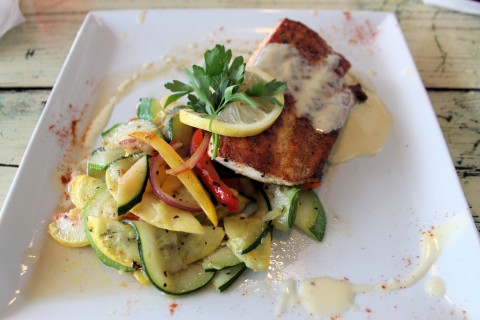 Wahoo is a member of the tuna and mackerel family. It's a streamlined speed demon, the better to function as a predator on other fish. Like tuna, it's more often cut into steaks than into fillets. Also like tuna, it doesn't stand to be overcooked. Do that, and it becomes dry and a bit tough. But like mackerel, it contains a good bit of fat, and has a bigger than average flavor. Very good eating.
The most common method of preparation for wahoo is grilling. However, it's also good in moist preparations, like bouillabaisse or courtbouillon. I once served wahoo with a light, tomato-and-holy-trinity sauce with more lemon and black pepper than I was used to finding, plus a few shrimp. It was a spectacular dish.
We used to see more wahoo lately than we have in the past few years. However, it's been the fish of the day here and there lately, so maybe it's making a comeback. It's underrated at the table, and I wish more chefs would use it.
Wahoo is a member of the tuna and mackerel family. It's a streamlined speed demon, the better to function as a predator on other fish. Like tuna, it's more often cut into steaks than into fillets. Also like tuna, it doesn't stand to be overcooked. Do that, and it becomes dry and a bit tough. But like mackerel, it contains a good bit of fat, and has a bigger than average flavor. Very good eating.
The most common method of preparation for wahoo is grilling. However, it's also good in moist preparations, like bouillabaisse or courtbouillon. I once served wahoo with a light, tomato-and-holy-trinity sauce with more lemon and black pepper than I was used to finding, plus a few shrimp. It was a spectacular dish.
We used to see more wahoo lately than we have in the past few years. However, it's been the fish of the day here and there lately, so maybe it's making a comeback. It's underrated at the table, and I wish more chefs would use it.
#24: Mahi-Mahi
Mahi-mahi is the Hawaiian name for a fish found in warm oceans worldwide, including in the Gulf of Mexico. Its other names are dorado and dolphinfish. I think the confusion caused by that latter name is why we use the Hawaiian one instead. Dolphinfish only look like dolphins--the marine mammal with so much brain power that it can train humans to gather around its tank and bring it fish. Dolphinfish, in contrast, are true fish. And a great fish to eat--not only delicious but less prone to overfishing than most fish. Mahi-mahi breed and grow so fast that its populations are stable. (So far, anyway.)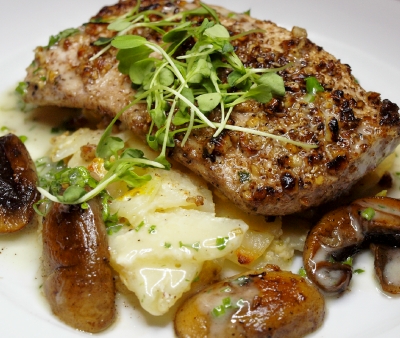 My first taste of mahi-mahi came neither in New Orleans nor Hawaii, but in San Francisco. Mason's, a faux-Polynesian restaurant in the Fairmont Hotel, was grilling the fish as early as the 1970s over kiawe wood (Hawaiian mesquite), along with several other Hawaiian fish. It was white with the faintest blush of pink, and had a firm, meaty texture. I thought it one of the best grilled fish I ever ate, and savored it as an exotic experience not likely to be duplicated at home. It wasn't two weeks before I did see it on a New Orleans menu. And it's been around ever since.
Mahi (it's on first-name basis with most waiters and chefs now) is a fine candidate for the grill. You want fillets that are at least three-quarters of an inch thick in the center. I prefer fillets to steaks of this fish, although both are found. It needs little preparation beyond a dusting of Creole seasoning. It benefits from an hour's marination in olive oil, white wine, and lemon juice, to break down its slight chewiness a bit. It also broils to good effect.
The sauce should be something simple, like a beurre blanc or the lighter forms of meuniere sauce. Or a sweet-spicy relish-like salsa, perhaps including fruit.
One of the few problems with mahi is that it needs to be trimmed carefully to remove blood lines and tough parts. It doesn't freeze very well, getting dry in the process. But there's plenty of fresh mahi to be had.
[divider type=""]
[title type="h2"]#25: Steelhead Trout.[/title]
Also known more generically as freshwater trout, these are small salmon caught in the rivers in or just outside of the mountains of the western United States. These are true trout, which is to say that they are members of the salmon family, something very obvious either before or after they're cooked. The steeleyes are almost the perfect size to feed on person. They are often served whole, or near to that state. They are not seen often around New Orleans, where when you mention trout you are more likely to be thinking about speckled trout--a much different fish.
[caption id="attachment_34382" align="alignleft" width="480"]
My first taste of mahi-mahi came neither in New Orleans nor Hawaii, but in San Francisco. Mason's, a faux-Polynesian restaurant in the Fairmont Hotel, was grilling the fish as early as the 1970s over kiawe wood (Hawaiian mesquite), along with several other Hawaiian fish. It was white with the faintest blush of pink, and had a firm, meaty texture. I thought it one of the best grilled fish I ever ate, and savored it as an exotic experience not likely to be duplicated at home. It wasn't two weeks before I did see it on a New Orleans menu. And it's been around ever since.
Mahi (it's on first-name basis with most waiters and chefs now) is a fine candidate for the grill. You want fillets that are at least three-quarters of an inch thick in the center. I prefer fillets to steaks of this fish, although both are found. It needs little preparation beyond a dusting of Creole seasoning. It benefits from an hour's marination in olive oil, white wine, and lemon juice, to break down its slight chewiness a bit. It also broils to good effect.
The sauce should be something simple, like a beurre blanc or the lighter forms of meuniere sauce. Or a sweet-spicy relish-like salsa, perhaps including fruit.
One of the few problems with mahi is that it needs to be trimmed carefully to remove blood lines and tough parts. It doesn't freeze very well, getting dry in the process. But there's plenty of fresh mahi to be had.
[divider type=""]
[title type="h2"]#25: Steelhead Trout.[/title]
Also known more generically as freshwater trout, these are small salmon caught in the rivers in or just outside of the mountains of the western United States. These are true trout, which is to say that they are members of the salmon family, something very obvious either before or after they're cooked. The steeleyes are almost the perfect size to feed on person. They are often served whole, or near to that state. They are not seen often around New Orleans, where when you mention trout you are more likely to be thinking about speckled trout--a much different fish.
[caption id="attachment_34382" align="alignleft" width="480"] Pesto steelhead trout at Zea.[/caption]
The local chain restaurant Zea is largely responsible for the appearance of steelheads in the New Orleans area. The fish is served after being pan-grilled, most notably with a light pesto crust. Zea features this continually on its menu. It's one of the best dishes on the menu, and because it comes from a reliable source it is almost always available there. But it's not local, so some local diners write it off.
Pesto steelhead trout at Zea.[/caption]
The local chain restaurant Zea is largely responsible for the appearance of steelheads in the New Orleans area. The fish is served after being pan-grilled, most notably with a light pesto crust. Zea features this continually on its menu. It's one of the best dishes on the menu, and because it comes from a reliable source it is almost always available there. But it's not local, so some local diners write it off.
#26: Atlantic Salmon
Our annual survey of seafood in Southeast Louisiana this year counts down the 33 best seafood species that we find more in restaurants than in homes. For the full survey so far, click here. Salmon is the most widely-served fish in the fine restaurants of the world. It's highly thought of wherever it's found fresh. And that's just about everywhere these days, courtesy of fish farming and air shipping. Salmon is meaty, tasty, and easy to cook in myriad ways. Edibly speaking, salmon fall into two categories: Atlantic and Pacific. They're different enough to appear twice in this countdown. The more common is the single Atlantic species, which occurs naturally throughout the northern Atlantic ocean on both sides. Atlantic salmon is also the one grown in fish farms--many of which, ironically, are in the Pacific Ocean. Around New Orleans, almost all of the salmon you see in stores and eat in restaurants is Atlantic. That's also the source of most smoked salmon, from Canada to Scandiavia.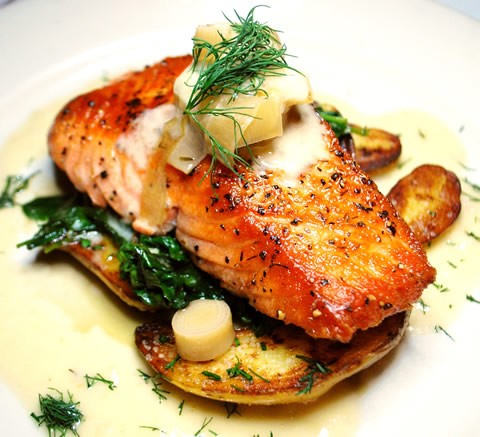 New Orleans gained an appreciation for salmon only in recent decades. Until the 1980s, you found it in one of two forms--one wonderful and the other horrible. The good kind was cold-smoked as an appetizer in fancy, European-style restaurants and the then-rare kosher-style delis. The other kind was canned, a product so bad in comparison to any other fish that many older Orleanians still have an aversion to eating salmon.
The reason we now find salmon on so many New Orleans menus--even though it has to be brought in thousands of miles away--has as much to do with its convenience for the seller as with its goodness. It's always available, unlike most local fish. A restaurant can place a standing order for a certain amount of salmon every week and forget about it. For other fish, he has to work the market every day. If the only fish a restaurant offers is salmon, you are in a restaurant that doesn't put a lot of time into obtaining its raw materials. But it could be worse. It could have been tilapia.
Fortunately, fresh salmon, nicely cut, even if it comes from a farm, is pretty good. It's also easy to cook, particularly on the grill or under the broiler.
One other issue: the environmental problems associated with salmon farms. They mess up the water and introduce a foreign species, notably in the southern hemisphere. Another reason to eat local. Or at least knowledgeably.
[divider type=""]
[title type="h2"]27: Squid (Calamari)[/title]
Squid come in all sizes, but the most familiar of them are the small ones from the Gulf that restaurants (particularly Italian ones) serve under the name calamari. In the most familiar squid dish, the cephalopods are coated with flour or cornmeal, deep-fried, then served with some kind of tomato-based sauce--either a cocktail sauce or spaghetti sauce, depending on the place.
No matter where you find fried calamari, you can bet on this: the chef and the regular customers will claim--loudly--that these are the best in the city. Maybe the world.
New Orleans gained an appreciation for salmon only in recent decades. Until the 1980s, you found it in one of two forms--one wonderful and the other horrible. The good kind was cold-smoked as an appetizer in fancy, European-style restaurants and the then-rare kosher-style delis. The other kind was canned, a product so bad in comparison to any other fish that many older Orleanians still have an aversion to eating salmon.
The reason we now find salmon on so many New Orleans menus--even though it has to be brought in thousands of miles away--has as much to do with its convenience for the seller as with its goodness. It's always available, unlike most local fish. A restaurant can place a standing order for a certain amount of salmon every week and forget about it. For other fish, he has to work the market every day. If the only fish a restaurant offers is salmon, you are in a restaurant that doesn't put a lot of time into obtaining its raw materials. But it could be worse. It could have been tilapia.
Fortunately, fresh salmon, nicely cut, even if it comes from a farm, is pretty good. It's also easy to cook, particularly on the grill or under the broiler.
One other issue: the environmental problems associated with salmon farms. They mess up the water and introduce a foreign species, notably in the southern hemisphere. Another reason to eat local. Or at least knowledgeably.
[divider type=""]
[title type="h2"]27: Squid (Calamari)[/title]
Squid come in all sizes, but the most familiar of them are the small ones from the Gulf that restaurants (particularly Italian ones) serve under the name calamari. In the most familiar squid dish, the cephalopods are coated with flour or cornmeal, deep-fried, then served with some kind of tomato-based sauce--either a cocktail sauce or spaghetti sauce, depending on the place.
No matter where you find fried calamari, you can bet on this: the chef and the regular customers will claim--loudly--that these are the best in the city. Maybe the world.
 But squid are less common in restaurants than they once were. And not as good, either. This seems to have happened at the time of hurricane Katrina. The storm killed the city's best fryer of squid--La Riviera in Metairie. No other restaurant has taken its place, although Sandro's (Metairie: 6601 Veterans Blvd. 504-888-7784) is close to equalling La Riviera's squid.
A few matters separate good squid from not-so-good squid. The first is how well they've been cleaned. Squid need to have the "pen" (a stiff sliver of cartilage), the ink sacs, and the little beak (one of which bit me once!) removed. Some squids are stuffed with eggs, but those shouldn't be cleaned out. They're a rare treat, one I haven't had in many years.
Lightness is crucial in frying squid, which can be tough when overcooked. (The texture is somewhat chewy to begin with.) I like to get not only the rings (the body cut crosswise) but the tentacles (which a friend once aptly described as "fried spiders").
Squid don't have to be fried, though. They can be sauteed in olive oil wirth garlic and herbs. They're excellent poached, then marinated in olive oil and herbs to make a cold antipasto. A wide range of great dishes combine squid with rice or pasta. Seafood risotto and cioppino are wonderful. Best of all are dishes using squid ink in the sauce. You see this everywhere in the Mediterranean, particularly in Spain and Italy.
Unacceptable Alternative: Big squid. Larger squid (and they can get so large that they can actually battle a sperm whale to the death) have been turning up on more local menus. They don't look like squid, because large sections of the body wall are cut into rectangles. They are most commonly boiled, then scored (so you can chew them) in sushi bars. Sometimes this kind of squid is grilled. I find it tough and flavorless. I always check to make sure that's not what's coming under the calamari brand. That isn't the local squid, anyway.
[divider type=""]
But squid are less common in restaurants than they once were. And not as good, either. This seems to have happened at the time of hurricane Katrina. The storm killed the city's best fryer of squid--La Riviera in Metairie. No other restaurant has taken its place, although Sandro's (Metairie: 6601 Veterans Blvd. 504-888-7784) is close to equalling La Riviera's squid.
A few matters separate good squid from not-so-good squid. The first is how well they've been cleaned. Squid need to have the "pen" (a stiff sliver of cartilage), the ink sacs, and the little beak (one of which bit me once!) removed. Some squids are stuffed with eggs, but those shouldn't be cleaned out. They're a rare treat, one I haven't had in many years.
Lightness is crucial in frying squid, which can be tough when overcooked. (The texture is somewhat chewy to begin with.) I like to get not only the rings (the body cut crosswise) but the tentacles (which a friend once aptly described as "fried spiders").
Squid don't have to be fried, though. They can be sauteed in olive oil wirth garlic and herbs. They're excellent poached, then marinated in olive oil and herbs to make a cold antipasto. A wide range of great dishes combine squid with rice or pasta. Seafood risotto and cioppino are wonderful. Best of all are dishes using squid ink in the sauce. You see this everywhere in the Mediterranean, particularly in Spain and Italy.
Unacceptable Alternative: Big squid. Larger squid (and they can get so large that they can actually battle a sperm whale to the death) have been turning up on more local menus. They don't look like squid, because large sections of the body wall are cut into rectangles. They are most commonly boiled, then scored (so you can chew them) in sushi bars. Sometimes this kind of squid is grilled. I find it tough and flavorless. I always check to make sure that's not what's coming under the calamari brand. That isn't the local squid, anyway.
[divider type=""]
#28: Swordfish
The well-named swordfish has been returning to menus and fish markets in recent years, after a brush with overfishing a decade ago. Management of the stocks in the Atlantic has made swordfish populations tenable again. If the program keeps up, the average swordfish--much smaller than it once was, will get bigger, too. The recreational fishing industry is a friend in this case, because swordfish are prized catches. A wall-mounted swordfish in the man-cave is a familiar cliche.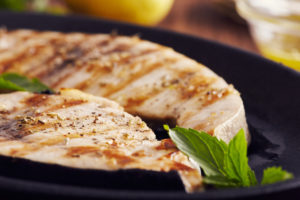 Swordfish can grow to be over a thousand pounds. More common are 100-to-300-pound specimens. A fish that big is not filleted, but steaked. A piece of swordfish resembles that of tuna in every way but color; the swordfish has a silvery bronze look. It contains less fat than tuna, but for some reason it doesn't get tough unless you really overcook it. That's where things get tricky. Swordfish requires more cooking than tuna does, so you have to work both ends of the thermometer. But a if steak-like fish that needs full cooking appeals to you, sword is the fish for you.
While all kinds of restaurants serve swordfish, I've always found Italian chefs do the best work with the species. ("Pesce spada" is the Italian name for the fish.) Particularly when grilled and served with the light, herbal sauces made from olive oil, garlic, crushed red pepper and herbs, swordfish shows off its unique flavors best.
Drawbacks To Swordfish
If there's a problem with eating swordfish, it's in its higher-than-average mercury content. That's a result of its being at the top of the ocean food chain. But it's no worse in that regard than tuna. Just don't eat it all the time.
[divider type=""]
Swordfish can grow to be over a thousand pounds. More common are 100-to-300-pound specimens. A fish that big is not filleted, but steaked. A piece of swordfish resembles that of tuna in every way but color; the swordfish has a silvery bronze look. It contains less fat than tuna, but for some reason it doesn't get tough unless you really overcook it. That's where things get tricky. Swordfish requires more cooking than tuna does, so you have to work both ends of the thermometer. But a if steak-like fish that needs full cooking appeals to you, sword is the fish for you.
While all kinds of restaurants serve swordfish, I've always found Italian chefs do the best work with the species. ("Pesce spada" is the Italian name for the fish.) Particularly when grilled and served with the light, herbal sauces made from olive oil, garlic, crushed red pepper and herbs, swordfish shows off its unique flavors best.
Drawbacks To Swordfish
If there's a problem with eating swordfish, it's in its higher-than-average mercury content. That's a result of its being at the top of the ocean food chain. But it's no worse in that regard than tuna. Just don't eat it all the time.
[divider type=""]

#29: Hake
is a legitimate Gulf species, caught frequently enough to appear on the menus of restaurants. If you find it, you are in a restaurant that puts more than the average amount of work into finding fish. I've found it on three or four times in the last year or two, always among specials. So perhaps its popularity is increasing. [caption id="attachment_54102" align="alignnone" width="480"]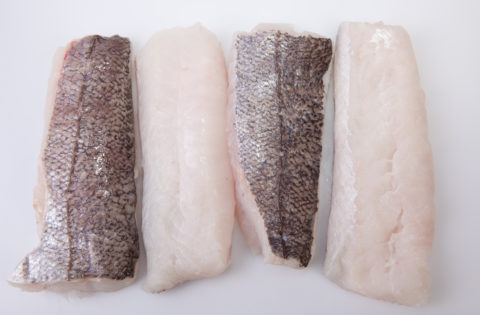 Gulf hake, filleted and ready for the steamer, the poaching pan, or light grilling.[/caption]
It's a funny-looking fish. It has a tail the comes to a point, with a continuous fin along its back and underside. It's like a standard fish in front and an eel in the back. It turns up in shrimp season, when it's found as a by-catch in shrimp nets. its flesh is white and flaky, and lends itself very well to the fish dishes we like to cook and order in restaurants. I'd say it comes out best sauteed; it's a little too soft for the grill, although some chefs prepare it that way. It's a sleeper of a species. Try it if hake ever comes your way.
[title type="h5"]Less Interesting Similar Fish: Cod[/title]
Hake is distantly related to codfish, whose demand peaks this time of year. Especially around St. Joseph's Day (March 19), when dried, salted codfish is a staple of the Sicilian St. Joseph dish called bacala. Which is worth getting only for making a religious statement.
[divider type=""]
Gulf hake, filleted and ready for the steamer, the poaching pan, or light grilling.[/caption]
It's a funny-looking fish. It has a tail the comes to a point, with a continuous fin along its back and underside. It's like a standard fish in front and an eel in the back. It turns up in shrimp season, when it's found as a by-catch in shrimp nets. its flesh is white and flaky, and lends itself very well to the fish dishes we like to cook and order in restaurants. I'd say it comes out best sauteed; it's a little too soft for the grill, although some chefs prepare it that way. It's a sleeper of a species. Try it if hake ever comes your way.
[title type="h5"]Less Interesting Similar Fish: Cod[/title]
Hake is distantly related to codfish, whose demand peaks this time of year. Especially around St. Joseph's Day (March 19), when dried, salted codfish is a staple of the Sicilian St. Joseph dish called bacala. Which is worth getting only for making a religious statement.
[divider type=""]
 #30: Lionfish.
Unless you're a scuba fisherman, chances are you will never encounter the lionfish. It's an invasive species from the Indian Ocean and the adjacent southern Pacific. Probably because it was brought in as an aquarium fish that got dumped into the Caribbean, Atlantic, and Gulf of Mexico, it preys on many of the most important commercial fish, notably snappers and groupers.
Not only does it spread rapidly to consume other fish that we would prefer for ourselves, but the lionfish is covered with venomous spines that can not only be painful but perhaps cause serious injury. On the other hand, it's a beautiful fish to look at.
All that said, you might have the opportunity to eat lionfish. It is worthwhile, with a firm, white flesh that tastes great. It's also a species that can be fished almost without limit, because of its notoriety. The chef who has done most to encourage the eating of liondish is Tenney Flynn, the co-owner of GWFins, which I would say is the best seafood restaurant in New Orleans. A fan of scuba, Tenney likes to go spearfishing for lionfish. He also knows how to get rid of the spines, and how to cut the fish to get the best parts. GWFins doesn't serve lionfish often, but it does turn up there for your amusement. It really is well worth eating.
[divider type=""]
[title type="h3"]#31: Alaskan King Crab[/title]
It may surprise some eaters that Alaskan king crab makes this list of best seafoods available around New Orleans at all. I see their point. Most Alaska king crab is not very good. That's the kind that was frozen who knows when and cooked who knows how. Those are the crab legs you see on boofays. It's pretty tasteless.
However, in the short season for Alaska king crab, a few seafood distributors get it down here fresh. Taste that, and you understand how king crab came to be famous. It's sweet, full of the flavor of the sea, and wonderful, eaten with just a little drawn butter, or nothing at all. You will get this only sporadically, when the fishing boats are active in the winter. There are three varieties--red, golden, and blue, with red being the best.
But you're lucky to get fresh king crab at all. The population crashed in the 1980s, and it's been hard to find since. A few restaurants--Notably GW Fins and Lilette--still get good king crab when it's available. Enjoy it while it's there, and get ready for a price much higher than you remember from when you first learned to eat it, in those cheapo steakhouses in the 1980s.
Expensive Alternative. Snow crab legs have filled the gap left by Alaskan king crab in the aforementioned low-end steak joints and casino buffets. Snow crab is only very distantly related to king crab, and tastes nothing like it. It doesn't taste like much at all to me. Certainly not as good as its reputation, or for the money. It's not terrible, though, with a somewhat sweet undertone in its flavor.
[divider type=""]
[title type="h3"]#32: Mackerel[/title]
First, we apply the anchovy test. Nobody's indifferent about that little Mediterranean fish, but everybody's familiar with them. And you either love them or hate them. If you like anchovies, please join my movement to get mackerel back on local menus.
New Orleans restaurants from the inexpensive to the fancy used to cook Spanish mackerel from the Gulf. Its popularity began to decline after World War II. Now it's hard fish to get unless you're a fisherman or know one. Sushi bars are about the only consistent restaurant servers of mackerel.
Aren't we supposed to be brave in our tastes in this chef-ruled world? That's what they say, but it's not true. Diners seem to be shrinking back from the unusual to the everyday in their tastes. Here's why they don't go for mackerel. It's a strong-flavored, oily fish. That's what its fans like about it. It's a good taste, but much more assertive than most people like in their fish. The average fish-eater would call it--ironically--"fishy." In any other food that cognate adjective would be a good thing. Don't you like orangy oranges? Beefy beef? Chocolatey chocolate desserts?
There's nothing weird about mackerel. The several species are related to tuna. Its populations in the Gulf are substantial. Because they're fast and effective predators, they quickly grow to twenty or more pounds--although smaller ones are better. Their meat is on the gray side (another turnoff for some people).
#30: Lionfish.
Unless you're a scuba fisherman, chances are you will never encounter the lionfish. It's an invasive species from the Indian Ocean and the adjacent southern Pacific. Probably because it was brought in as an aquarium fish that got dumped into the Caribbean, Atlantic, and Gulf of Mexico, it preys on many of the most important commercial fish, notably snappers and groupers.
Not only does it spread rapidly to consume other fish that we would prefer for ourselves, but the lionfish is covered with venomous spines that can not only be painful but perhaps cause serious injury. On the other hand, it's a beautiful fish to look at.
All that said, you might have the opportunity to eat lionfish. It is worthwhile, with a firm, white flesh that tastes great. It's also a species that can be fished almost without limit, because of its notoriety. The chef who has done most to encourage the eating of liondish is Tenney Flynn, the co-owner of GWFins, which I would say is the best seafood restaurant in New Orleans. A fan of scuba, Tenney likes to go spearfishing for lionfish. He also knows how to get rid of the spines, and how to cut the fish to get the best parts. GWFins doesn't serve lionfish often, but it does turn up there for your amusement. It really is well worth eating.
[divider type=""]
[title type="h3"]#31: Alaskan King Crab[/title]
It may surprise some eaters that Alaskan king crab makes this list of best seafoods available around New Orleans at all. I see their point. Most Alaska king crab is not very good. That's the kind that was frozen who knows when and cooked who knows how. Those are the crab legs you see on boofays. It's pretty tasteless.
However, in the short season for Alaska king crab, a few seafood distributors get it down here fresh. Taste that, and you understand how king crab came to be famous. It's sweet, full of the flavor of the sea, and wonderful, eaten with just a little drawn butter, or nothing at all. You will get this only sporadically, when the fishing boats are active in the winter. There are three varieties--red, golden, and blue, with red being the best.
But you're lucky to get fresh king crab at all. The population crashed in the 1980s, and it's been hard to find since. A few restaurants--Notably GW Fins and Lilette--still get good king crab when it's available. Enjoy it while it's there, and get ready for a price much higher than you remember from when you first learned to eat it, in those cheapo steakhouses in the 1980s.
Expensive Alternative. Snow crab legs have filled the gap left by Alaskan king crab in the aforementioned low-end steak joints and casino buffets. Snow crab is only very distantly related to king crab, and tastes nothing like it. It doesn't taste like much at all to me. Certainly not as good as its reputation, or for the money. It's not terrible, though, with a somewhat sweet undertone in its flavor.
[divider type=""]
[title type="h3"]#32: Mackerel[/title]
First, we apply the anchovy test. Nobody's indifferent about that little Mediterranean fish, but everybody's familiar with them. And you either love them or hate them. If you like anchovies, please join my movement to get mackerel back on local menus.
New Orleans restaurants from the inexpensive to the fancy used to cook Spanish mackerel from the Gulf. Its popularity began to decline after World War II. Now it's hard fish to get unless you're a fisherman or know one. Sushi bars are about the only consistent restaurant servers of mackerel.
Aren't we supposed to be brave in our tastes in this chef-ruled world? That's what they say, but it's not true. Diners seem to be shrinking back from the unusual to the everyday in their tastes. Here's why they don't go for mackerel. It's a strong-flavored, oily fish. That's what its fans like about it. It's a good taste, but much more assertive than most people like in their fish. The average fish-eater would call it--ironically--"fishy." In any other food that cognate adjective would be a good thing. Don't you like orangy oranges? Beefy beef? Chocolatey chocolate desserts?
There's nothing weird about mackerel. The several species are related to tuna. Its populations in the Gulf are substantial. Because they're fast and effective predators, they quickly grow to twenty or more pounds--although smaller ones are better. Their meat is on the gray side (another turnoff for some people).
 Like Charlie the Tuna, Spanish mackerel has good taste. It likes to eat speckled trout. And it tastes good, too. You can cook mackerel in all the usual ways. It's quite good fried. Broiled or grilled is nice, too. Sauces with big flavors of their own are natural companions, because the flavor of mackerel stands up to them. (I'm thinking of the preparation several local Italian restaurants make with artichokes, olives, capers, mushrooms, lemon and butter.)
The mackerel in sushi bars are very small. (I'm not sure they're local.) The great way to have it prepared is as raw sashimi, cut right off the whole fish. Then the remainder of the fish (head, bones, tail, skin) is sent to the kitchen, which fries it. You can eat that pretty much whole. Exotic, but delicious.
[divider type=""]
Like Charlie the Tuna, Spanish mackerel has good taste. It likes to eat speckled trout. And it tastes good, too. You can cook mackerel in all the usual ways. It's quite good fried. Broiled or grilled is nice, too. Sauces with big flavors of their own are natural companions, because the flavor of mackerel stands up to them. (I'm thinking of the preparation several local Italian restaurants make with artichokes, olives, capers, mushrooms, lemon and butter.)
The mackerel in sushi bars are very small. (I'm not sure they're local.) The great way to have it prepared is as raw sashimi, cut right off the whole fish. Then the remainder of the fish (head, bones, tail, skin) is sent to the kitchen, which fries it. You can eat that pretty much whole. Exotic, but delicious.
[divider type=""]
#33: Groupers In General
The groupers are more popular in Florida than in Louisiana. But groupers are commonly caught in Gulf waters, and show up ever more frequently on local menus. Groupers come in a number of species, some better than others. The best of them is Warsaw grouper, a large (as much as forty pounds) fish with enormous flakes. I've seen individual flakes of it served, interleaved with other seafood or vegetables for a handsome effect. Yellowfin grouper--a smaller fish--is more likely to be the one offered as the fish of the day on New Orleans menus. [caption id="attachment_41456" align="alignnone" width="480"]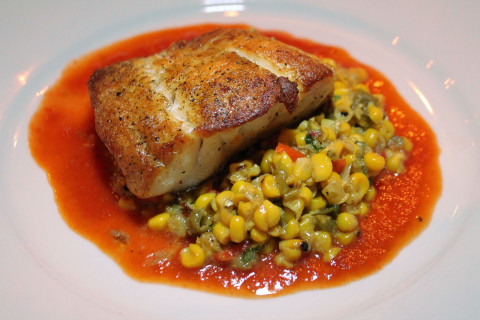 Grouper with corn macque choux at Apolline.[/caption]
The color of cooked grouper is very white. That has a lot of appeal to most diners, which is one reason chefs like it. As does another characteristic of the fish--its mild flavor. A little too mild for my tastes, in fact. Whenever grouper comes my way I always marinate it a few minutes in olive oil, give it a good crusting of Creole seasoning, and either grill or broil it. More polite methods of preparation--notably, poaching the fish in water or stock, with lemon juice, Worcestershire, and herbs. That will result in the very subtly-flavored, very low-fat fish preferred by those who say they don't like their fish to taste "fishy." (What a thing to be thought of as undesirable!)
[divider type=""]
Grouper with corn macque choux at Apolline.[/caption]
The color of cooked grouper is very white. That has a lot of appeal to most diners, which is one reason chefs like it. As does another characteristic of the fish--its mild flavor. A little too mild for my tastes, in fact. Whenever grouper comes my way I always marinate it a few minutes in olive oil, give it a good crusting of Creole seasoning, and either grill or broil it. More polite methods of preparation--notably, poaching the fish in water or stock, with lemon juice, Worcestershire, and herbs. That will result in the very subtly-flavored, very low-fat fish preferred by those who say they don't like their fish to taste "fishy." (What a thing to be thought of as undesirable!)
[divider type=""]